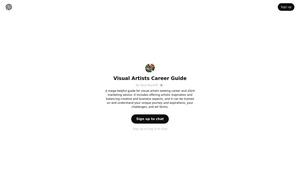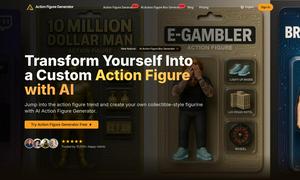
Discover the Best AI Tools to Boost Your Productivity
Find the Best AI Tools to Optimize Your Work and Personal Tasks
Best Creative Arts AI Tools in 2024

What is Creative Arts
The Creative Arts Category in the AI Directory showcases innovative tools and platforms that enhance artistic expression and creativity. Users benefit from access to cutting-edge technologies for design, music, writing, and more, enabling them to produce high-quality content effortlessly. Explore unique features to ignite your imagination.
How Creative Arts works
The Creative Arts Category connects users with a range of innovative tools designed to enhance creative projects. Users can browse through various offerings based on their needs, whether it's graphic design, music production, or writing assistance. Each tool provides unique features tailored to specific creative tasks, enabling users to enhance their projects efficiently. By integrating these tools into their workflows, artists can simplify processes, experiment with new ideas, and ultimately elevate the quality of their creative outputs.
What are the advantages of Creative Arts?
The advantages of the Creative Arts Category are manifold, including access to cutting-edge tools that increase efficiency and enhance artistic expression. By utilizing these innovative resources, artists can streamline their creative workflows, explore new techniques, and produce high-quality content. This category not only caters to a variety of creative needs but also fosters collaboration and inspiration among users, providing a significant value boost in their artistic endeavors.
Key Features for Creative Arts
Innovative Tools for Artistic Expression
The Creative Arts Category features innovative tools for artistic expression, allowing users to create unique projects across various media. From graphic design software to music production platforms, these resources streamline the creative process, enabling users to produce captivating content that reflects their vision effortlessly.
Collaborative Projects and Community Engagement
Collaboration is a standout feature of the Creative Arts Category, facilitating community engagement among artists. These platforms promote teamwork by allowing users to share ideas and feedback, thus enhancing creativity and encouraging diverse artistic collaborations that lead to unique outcomes and shared experiences.
User-Friendly Interfaces and Accessibility
User-friendly interfaces define the Creative Arts Category, making tools accessible to artists of all skill levels. These platforms are designed to simplify the creative process, allowing anyone to navigate and utilize advanced features quickly, ultimately fostering inclusivity and encouraging more people to explore their artistic potential.
Use Cases for Creative Arts?
The Creative Arts Category is valuable across numerous use cases, including graphic design projects, songwriting, educational initiatives, and multimedia art installations. For instance, a graphic designer may use specialized software to create stunning visuals, while a musician might rely on advanced production tools to compose and mix tracks. Educators can adopt these tools to teach creative subjects, helping students explore their artistic potential. In each scenario, the solutions offered in this category effectively address user needs, streamline processes, and enhance the overall creative output.
FAQs for Creative Arts
What unique features enhance creativity in the Creative Arts Category?
The Creative Arts Category offers several unique features that enhance creativity, including innovative tools designed to facilitate artistic expression. These tools streamline processes, allowing artists to focus on their craft rather than getting bogged down by technicalities. Users can easily integrate these resources into their workflows, encouraging exploration and experimentation while producing high-quality work.
How does collaboration enhance the user experience in the Creative Arts Category?
Collaboration significantly enhances the user experience in the Creative Arts Category by fostering community engagement and creative synergy. Artists can connect with peers, share feedback, and participate in collective projects, leading to richer ideas and improved outcomes. This collaborative approach not only enhances individual creativity but also builds a supportive network that nurtures artistic growth.
What role does accessibility play in the Creative Arts Category's tools?
Accessibility plays a crucial role in the Creative Arts Category's tools, ensuring that artists of all skill levels can utilize innovative resources effectively. User-friendly interfaces and comprehensive tutorials facilitate ease of use, enabling creators to focus on their artistic endeavors without being hindered by complex processes, thereby broadening the reach of creative tools.
What competitive advantages does the Creative Arts Category offer its users?
The Creative Arts Category stands out by offering users competitive advantages such as access to cutting-edge technology, extensive collaboration features, and a wide range of artistic tools tailored to diverse needs. These elements combine to create a robust and valuable resource, empowering artists to enhance their creativity and productivity in the saturated creative landscape.
What specific benefits can artists gain from using tools in the Creative Arts Category?
Artists can gain numerous benefits from using tools in the Creative Arts Category, including increased efficiency, enhanced collaboration, and improved quality of work. By leveraging innovative features that streamline processes and foster creativity, artists can produce striking, high-quality content that effectively communicates their vision, ultimately enriching their artistic journey.
How do users interact with tools in the Creative Arts Category to maximize their benefits?
Users interact with tools in the Creative Arts Category by seamlessly integrating them into their creative workflows, allowing for the maximization of benefits. By experimenting with the various features offered, artists can tailor their processes to their specific needs, collaborate effectively with others, and produce exemplary work that reflects their unique artistic perspectives.





